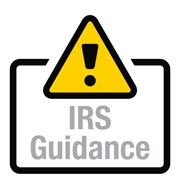Blog
IRS Issues Proposed Guidance on Complicated QBI Deduction Rules
IRS Issues Proposed Guidance on Complicated QBI Deduction Rules

The IRS has finally issued eagerly awaited regulations addressing the new deduction for up to 20% of qualified business income (QBI) from pass-through entities. The QBI deduction was a major piece of the Tax Cuts and Jobs Act, which was signed into law last December.
The deduction is available to eligible owners of pass-through entities for tax years beginning in 2018 through 2025. The deduction will sunset after 2025 unless Congress extends it.
Key Definition
For QBI deduction purposes, the term “pass-through” entities refers to:
- Sole proprietorships,
- Single-member (one owner) limited liability companies (LLCs) that are treated as sole proprietorships for tax purposes,
- Partnerships,
- LLCs that are treated as partnerships for tax purposes, and
- S corporations.
The QBI deduction is only available to individuals, estates and trusts with income from eligible pass-through entities. The new proposed regs refer to all three as “individuals.” We will follow that terminology to stay consistent with the proposed regs.
Eligible Businesses
In defining what constitutes a business for QBI deduction eligibility purposes, the IRS references Section 162 of the Internal Revenue Code. Unfortunately, this section of the tax code doesn’t explicitly define the terms “trade” or “business.” However, case law and administrative guidance based on Sec. 162 generally characterize a trade or business as an activity engaged in with continuity and regularity — and with an income or profit motive. Rather than relying on bright-line rules, Sec. 162 identifies a trade or business based on an examination of the facts in each case.
At this time, it’s still not entirely clear when a rental activity can qualify as a Sec. 162 trade or business for QBI deduction purposes. That said, the proposed regs specify that a rental activity can qualify as a trade or business under a special exception: When the rental or licensing of tangible or intangible property doesn’t rise to the level of a Sec. 162 trade or business, the rental or licensing activity is still treated as a trade or business for QBI deduction purposes — if the property is rented or licensed to a trade or business that’s commonly controlled.
For example, the common-control exception would apply when an individual owns a single-member LLC that owns an intangible asset and licenses it to a corporation that’s owned at least 50% by the same individual. The single-member LLC’s licensing income would count as QBI that’s passed through to the LLC’s owner. (This assumes the single-member LLC is treated as the owner’s sole proprietorship for tax purposes.)
When final QBI regs are issued, they may include safe-harbor rules that taxpayers can rely on for classifying activities as businesses (or not) for QBI deduction purposes.
Ineligible Income
Income from the trade or business of being an employee doesn’t count as QBI. Reasonable salary received by an S corporation shareholder-employee and guaranteed payments received by a partner (or an LLC member treated as a partner for tax purposes) for services rendered to a partnership (LLC) are also excluded from QBI.
Close-Up on Limitations
If you’ve read previous articles on the QBI deduction, you already know that the deduction is subject to numerous rules and limitations. The limitations begin to phase in when the individual’s taxable income (calculated before any QBI deduction) exceeds $157,500, or $315,000 for married people who file jointly.
The limitations are fully phased in once taxable income exceeds $207,500 for unmarried people, or $415,000 for married people who file jointly. After it’s fully phased in, the QBI deduction is limited to the greater of:
- The individual’s share of 50% of W-2 wages paid to employees and properly allocable to QBI during the tax year, or
- The sum of the individual’s share of 25% of such W-2 wages plus the individual’s share of 2.5% of the unadjusted basis immediately after acquisition (UBIA) of qualified property.
The QBI deduction can never exceed the lesser of:
- 20% of QBI, or
- 20% of the individual’s taxable income calculated before 1) any QBI deduction, and 2) any net capital gain amount (net long-term capital gains in excess of net short-term capital losses plus qualified dividends).
The proposed regs explain how to calculate a business’s W-2 wages for purposes of applying the QBI deduction limitations. A business’s UBIA of qualified property generally equals the original cost. Qualified property means depreciable tangible property (including real estate) that:
- Is owned by a qualified business as of its tax year end,
- Is used by that business at any point during the tax year for the production of QBI, and
- Hasn’t reached the end of its depreciable period by the tax year-end.
Aggregating Businesses
By aggregating (combining) businesses, an individual with taxable income that’s high enough to be affected by the limitations based on W-2 wages and the UBIA of qualified property may be able to claim a bigger QBI deduction than if the businesses were considered separately.
For instance, say a high-income individual owns an interest in a business with substantial QBI but little or no W-2 wages and an interest in a second business with minimal QBI but significant W-2 wages. Aggregating the two businesses can result in a higher QBI deduction than if the deduction were separately calculated for each business based on that business’s W-2 wages and UBIA of qualified property.
The proposed regs set forth tests to determine whether the aggregation of businesses is allowed. The rules for aggregating businesses for purposes of the QBI deduction are notrelated, in any way, to how they might be aggregated for other tax-law purposes (such as the passive activity loss rules) and vice versa.
Service Trades or Businesses
Under the proposed regs, a specified service trade or business (SSTB) can’t be aggregated with any other business. Status as an SSTB (or not) is important, because QBI deductions based on SSTB income begin to be phased out when an owner’s taxable income (calculated before any QBI deduction) exceeds $157,500, or $315,000 for a married couple who files jointly. Phaseout is complete when taxable income exceeds $207,500, or $415,000 for a married couple who files jointly. At that point, no QBI deduction based on SSTB income is allowed.
The term “SSTB” refers to any trade or business involving the performance of services in one or more of the following fields:
 Health,
Health,- Law,
- Accounting (and actuarial science),
- Consulting,
- Financial, brokerage, investing, and investment management services,
- Investment trading,
- Dealing in securities, partnership interests, or commodities,
- Athletics and performing arts, and
- Any trade or business where the principal asset is the reputation or skill of one or more of its employees or owners.
Before the proposed regs were released, there was concern that the last item on the list could snare unsuspecting businesses, such as restaurants with well-known chefs. Fortunately, the proposed regs limit the definition to trades or businesses that receive fees, compensation, or other income for:
- Endorsing products or services,
- Using an individual’s image, likeness, name, signature, voice, trademark or any other symbol associated with that individual’s identity, and/or
- Appearing at an event or on a media format (such as a radio or television appearance).
Note: Architecture and engineering firms aren’t considered SSTBs.
The proposed guidance also includes an antiabuse rule intended to prevent service business owners from separating out parts of what would otherwise be an integrated SSTB, such as an optometry practice’s retail sales of vision-care items, to make income from the separated (nonservice) segment eligible for the QBI deduction.
Contact Us
This article only scratches the surface of the proposed regs. Your PDR tax advisor can help you sort through the details to get the most from the QBI deduction based on your specific circumstances.
Scope of the Proposed Regs
The proposed regulations for the qualified business income (QBI) deduction are long and complex. In addition to issues discussed in the main article, the proposed regs include:
- Operational rules for determining QBI deductions. These include guidance on how to apply the phaseout rules that can reduce or eliminate QBI deductions for individuals with taxable income (calculated before any QBI deduction) that exceeds the phaseout threshold of $157,500, or $315,000 for married people who file jointly.
- Definitions of QBI and other terms of art used to apply the QBI deduction rules. For example, the term “QBI” refers to the net amount of qualified items of income, gain, deduction and loss from an eligible trade or business.
- Guidance on when QBI deductions can be claimed based on qualified income from publicly traded partnerships (PTPs) and qualified dividends from real estate investment trusts (REITs).
- Special computational and reporting rules that pass-through entities, PTPs, trusts and estates may need to follow to provide their owners and beneficiaries with the information necessary to calculate allowable QBI deductions at the owner or beneficiary level.
While these regulations are in proposed form, taxpayers can rely on them until final regs are issued.
©2018
Schedule a Consultation
Newsletter Sign-Up
Sign up for industry accounting and tax tips below

 Health,
Health,